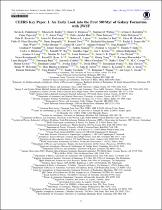| dc.contributor.author | Finkelstein, Steven L. | |
| dc.contributor.author | Bagley, Micaela B. | |
| dc.contributor.author | Davé, Romeel | |
| dc.date.accessioned | 2023-04-18T08:48:25Z | |
| dc.date.available | 2023-04-18T08:48:25Z | |
| dc.date.issued | 2023 | |
| dc.identifier.citation | Finkelstein, S. L. et al. (2023). Ceers key paper. I. An early look into the first 500myr of galaxy formation with jwst. Astrophysical Journal Letters, 946(1), L13. https://doi.org/10.3847/2041-8213/acade4 | en_US |
| dc.identifier.issn | 2041-8213 | |
| dc.identifier.uri | https://doi.org/10.3847/2041-8213/acade4 | |
| dc.identifier.uri | http://hdl.handle.net/10566/8824 | |
| dc.description.abstract | We present an investigation into the first 500 Myr of galaxy evolution from the Cosmic Evolution Early Release
Science (CEERS) survey. CEERS, one of 13 JWST ERS programs, targets galaxy formation from z ∼ 0.5 to >10
using several imaging and spectroscopic modes. We make use of the first epoch of CEERS NIRCam imaging,
spanning 35.5 arcmin2
, to search for candidate galaxies at z > 9. Following a detailed data reduction process
implementing several custom steps to produce high-quality reduced images, we perform multiband photometry
across seven NIRCam broad- and medium-band (and six Hubble broadband) filters focusing on robust colors and
accurate total fluxes. We measure photometric redshifts and devise a robust set of selection criteria to identify a
sample of 26 galaxy candidates at z ∼ 9–16. These objects are compact with a median half-light radius of ∼0.5 kpc.
We present an early estimate of the z ∼ 11 rest-frame ultraviolet (UV) luminosity function, finding that the number
density of galaxies at MUV ∼ −20 appears to evolve very little from z ∼ 9 to 11. We also find that the abundance
(surface density [arcmin−2
]) of our candidates exceeds nearly all theoretical predictions. We explore potential
implications, including that at z > 10, star formation may be dominated by top-heavy initial mass functions, which
would result in an increased ratio of UV light per unit halo mass, though a complete lack of dust attenuation and/or
changing star formation physics may also play a role. | en_US |
| dc.language.iso | en | en_US |
| dc.publisher | American Astronomical Society | en_US |
| dc.subject | Astronomy | en_US |
| dc.subject | Physics | en_US |
| dc.subject | Galaxies | en_US |
| dc.subject | Cosmology | en_US |
| dc.title | Ceers key paper. I. An early look into the first 500myr of galaxy formation with jwst | en_US |
| dc.type | Article | en_US |

